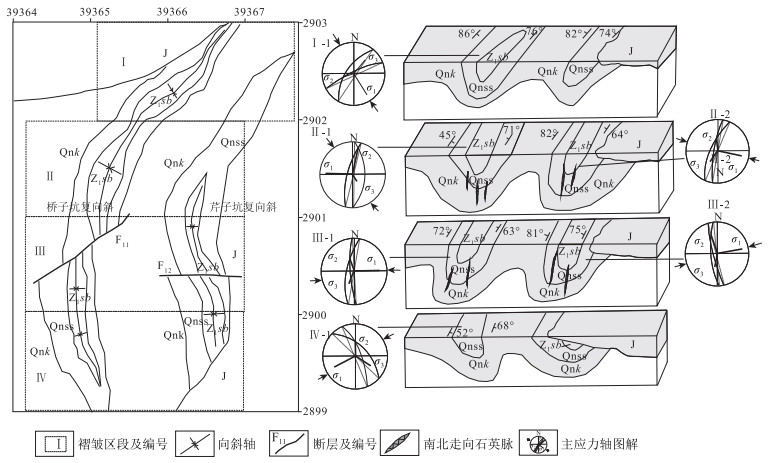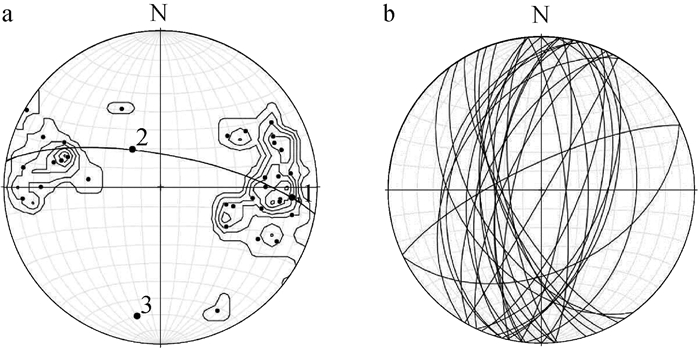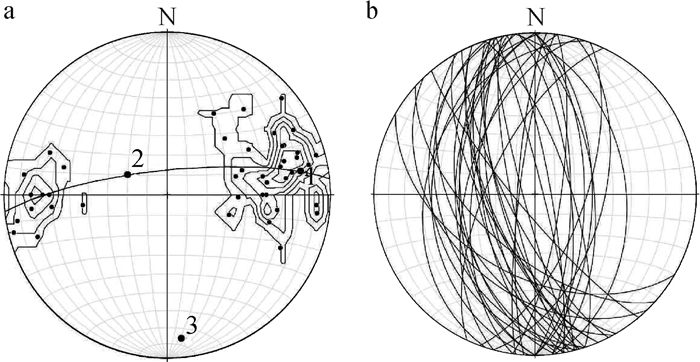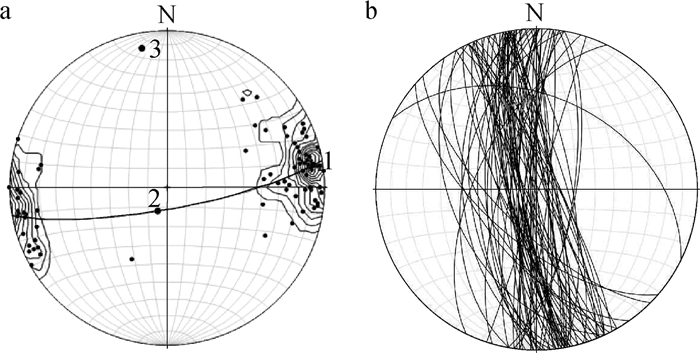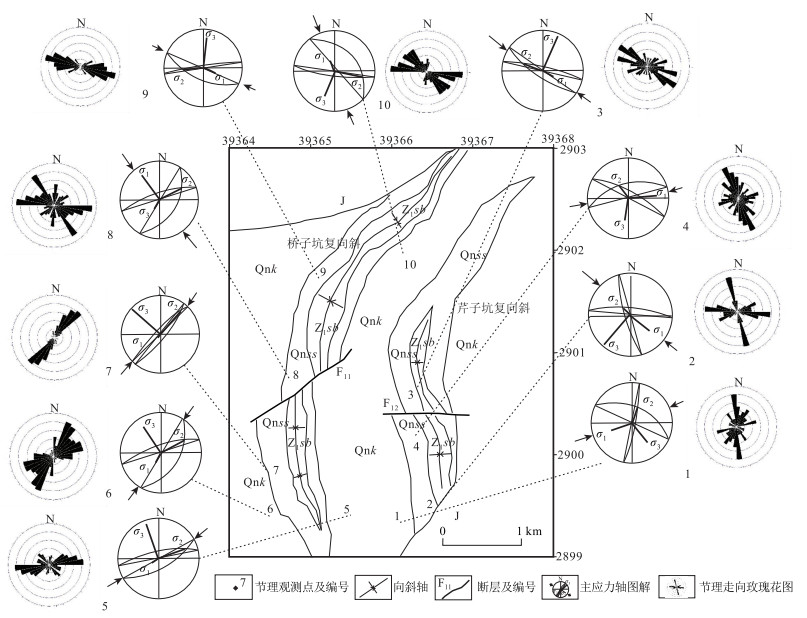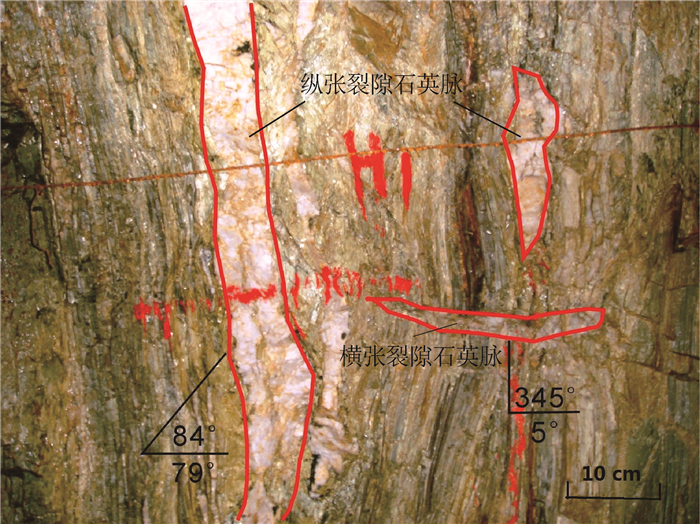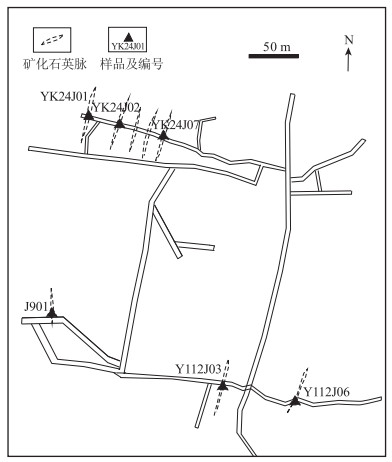Research on the characteristics of basement fold structure and SN-trending mineralization zone in the Yinkeng lead-zinc-silver orefield in Jiangxi
-
摘要:
为了探究银坑铅锌银多金属矿田的构造特征和找矿潜力,选取区内基底复式褶皱作为研究区,开展野外调查和室内分析。揭示基底褶皱几何学和应力场特征并探讨对成矿的控制作用,重点研究褶皱作用晚期纵张断裂中的SN向交代充填石英矿脉的成矿特征。通过实测褶皱轴迹与两翼产状,分析其几何形态特征为:枢纽走向由北至南为NE→NNE→SN→NNW,翼间角范围为33°~52°,褶皱类型为紧闭陡立尖棱状褶皱。通过褶皱分析法与节理统计法,求得基底褶皱自加里东期至燕山期主应力方向变化为EW→NWW→NNW→NEE。基底地层早期受EW向挤压而形成SN向构造带与大量的SN向褶劈理带。应力场转换期间地层受到的应力由挤压向拉张转换,促进褶劈理带内形成SN向纵张裂隙,为后期NE向矿化提供空间。通过实测与观察,基底褶皱首次发现近SN向矿化石英矿脉充填于褶皱作用晚期的切层纵张和次级横张裂隙。含矿性分析显示,脉中铅、锌平均含量为0.133%和0.190%,金、银的平均含量0.127 g/t和15.33 g/t,具有较高的矿化特征。在桥子坑矿区地表和牛形坝矿区60、104和140中段新发现12条SN向矿脉,表明该区有巨大的成矿潜力。
Abstract:In order to explore the structural characteristics and prospecting potential of the Yinkeng lead-zinc-silver polymetallic orefield, the authors selected the basement folds in this area as the research area to conduct field investigation and indoor analysis and reveal the basement fold geometry and stress field characteristics. The focus was on the mineralization characteristics of SN-trending metasomatic filling quartz veins, which are developed in the longitudinal tension faults formed in the late stage of folding. Through the actual measurement of the fold axis trace and the attitudes of the two wings, the geometric characteristics were summarized as follows: the direction of the hub is NE→NNE→SN→NNW from north to south, the angle between wings ranges from 33°to 52°, and the fold type is the closed, steep and sharp prismatic fold. Through the fold analysis method and the joint statistical method, the principal stress directions of the basement folds from the Caledonian to the Yanshanian were EW→NWW→NNW→NEE. The basement strata were squeezed in the EW direction in the early stage to form an SN-trending structural belt and a large number of SN-trending fold cleavage belts. During the transition of the stress field, the stress on the formation changed from compression to tension, which promoted the formation of SN-trending longitudinal fractures in the fold cleavage zone, and provided space for later NS-trending mineralization.Through actual measurement and observation, it is the first time to discover mineralized quartz veins in nearly SN direction in the basement fold. This quartz vein filled the longitudinal and secondary transverse tension fractures in the section at the late stage of folding. Mineralization analysis shows that the quartz vein has high mineralization characteristics. The average values of lead and zinc in mineralized quartz veins are 0.133% and 0.190%, and the average values of gold and silver are 0.127 g/t and 15.33 g/t. Twelve new SN-trending veins were discovered on the surface of the Qiaozikeng mining area and the 60, 104, and 140 level of the Niuxingba mining area, indicating that this area has huge metallogenic potential.
-

-
图 1 江西银坑矿田构造位置图(a)及研究区地质简图(b)(底图据参考文献[9])
Figure 1.
图 2 江西银坑铅锌银矿田构造简图(底图据参考文献[9])
Figure 2.
图 4 银坑矿田基底褶皱几何形态及应力场分布图(地层代号注释同图 2)
Figure 4.
图 10 银坑矿田基底褶皱应力场分布图(地层代号注释同图 2)
Figure 10.
表 1 桥子坑-芹子坑复式向斜构造产状及应力方向数据
Table 1. Data of attitude and stress direction of Qiaozikeng-Qinzikeng compound syncline structure
区段
编号位置 产状
数量两翼岩层的优选产状 枢纽产状 轴面产状 点应力状态 东翼 西翼 σ1 σ2 σ3 Ⅰ-1 桥子坑复向斜 13 151°∠44° 313°∠51° 32°∠6° 326°∠82° 147°∠17 ° 256°∠54 ° 39°∠37° Ⅱ-1 桥子坑复向斜 32 287°∠45° 96°∠55° 183°∠11° 104°∠84° 279°∠8°、 12°∠6 °、 135°∠74° Ⅱ-2 芹子坑复向斜 11 272°∠52° 83°∠57° 182°∠11° 271°∠85°。 101°∠12 ° 4°∠31° 216°∠41° Ⅲ-1 桥子坑复向斜 43 266°∠41° 75°∠53° 174°∠12° 261°∠86°。 92°∠18 ° 351°∠36° 208°∠44° Ⅲ-2 芹子坑复向斜 88 233°∠74° 95°∠76° 345°∠12° 252°∠86° 85°∠10 ° 337°∠36° 182°∠51° Ⅳ-1 桥子坑复向斜 50 244°∠45° 66°∠52° 155°∠6° 66°∠78° 244°∠27 ° 351°∠36 ° 117°∠38° 注:测试精度为1°,误差为5° 表 2 银坑矿田基底褶皱节理统计数据
Table 2. Statistical data of basement fold joints in the Yinkeng orefield
点号 位置 构造归属 地层及岩性 节理
条数共轭剪节理产状 主应力轴方向 S1 S2 σ1 σ3 1 八公排南 芹子坑复向斜南部西翼 Qnk变质凝灰质砂岩 66 101°∠79° 25°∠46° 141°∠24° 253°∠31° 2 五公坑南 芹子坑复向斜南部中部 Qnk变质砂岩 191 252°∠74° 6°∠74° 129°∠25° 220°∠1° 3 樟树坳东 芹子坑复向斜南部中部 Qnss变质沉凝灰岩 178 11°∠79° 214°∠71° 120°∠55° 21°∠6° 4 樟树坳东 芹子坑复向斜南部西翼 Qnss变质凝灰质砂岩 172 343°∠52° 28°∠71° 84°∠21° 186°∠29° 5 秀坑北东 桥子坑复向斜南部西翼 Qnk粉砂岩 163 347°∠71° 150°∠61° 233°∠69° 342°∠7° 6 茶背东 桥子坑复向斜南部西翼 Qnk砂质、粉砂质板岩 177 340°∠69° 121°∠40° 206°∠60° 324°∠14° 7 大山排东南 桥子坑复向斜南部西翼 Qnss板岩 168 313°∠77° 127°∠71° 210°∠76° 311°∠2° 8 大山西 桥子坑复向斜南部西翼 Qnss板岩 158 92°∠72° 139°∠75° 205°∠4° 295°∠16° 9 松山背东 桥子坑复向斜北部西翼 Qnk变质凝灰质粉砂岩 170 350°∠83° 203°∠54° 115°∠51° 8°∠14° 10 桥子坑东 桥子坑复向斜北部东翼 Qnk凝灰质板岩 158 186°∠76° 48°∠30° 338°∠57° 201°∠24° 注:测试精度为1°,误差为5°;表中地层代号注释同图 2 表 3 银坑矿田桥子坑矿区SN向矿化石英脉主要成矿元素含量
Table 3. Content of main metallogenic elements in the Qiaozikeng mining area, Yinkeng orefield
10-6 元素 YK24J01 YK24J02 YK24J07 J901 Y112J03 Y112J06 地壳
丰度[30]Pb 93.60 6890.00 25.60 40.00 842.00 46.60 12.50 Zn 788.00 >10000 169.00 142.00 115.00 39.00 70.00 Ag 2.77 7.33 0.29 2.53 78.40 0.54 0.07 Au 0.02 0.28 0.02 0.05 0.41 <0.005 0.00 Cu 231.00 226.00 109.50 55.50 448.00 6.10 60.00 W 37.80 2.20 5.50 1.80 0.80 1.10 1.25 Mn 1800.00 425.00 2070.00 2930.00 4850.00 850.00 950.00 Mo 1.56 1.62 1.34 11.60 1.60 2.84 1.20 Sb 1.43 4.21 0.83 1.19 2.59 0.35 0.20 注:样品由澳实分析检测(广州)有限公司测定,Au分析方法为火试金法,其他为质谱/光谱仪 -
[1] 张家菁.赣南东部银坑矿田控矿因素及找矿方向浅析[J].江西地质, 1997, (4):23-29. http://kns.cnki.net/KCMS/detail/detail.aspx?dbcode=CJFD&filename=JXDZ704.003
[2] 梅勇文.江西南部推(滑)覆构造系统研究[J].江西地质, 1997, (3):52-60. http://www.cnki.com.cn/Article/CJFDTotal-JXDZ703.008.htm
[3] 高贵荣, 林长仔.于都县银坑矿田F_1断裂特征及其控矿作用[J].江西地质, 2000, (1):49-53. http://d.wanfangdata.com.cn/Periodical_jxdz200001009.aspx
[4] 陈毓川, 裴荣富, 王登红.三论矿床的成矿系列问题[J].地质学报, 2006, (10):1501-1508. http://d.wanfangdata.com.cn/periodical/dizhixb200610003
[5] 陈毓川, 王登红, 徐志刚, 等.对中国成矿体系的初步探讨[J].矿床地质, 2006, (2):155-163. http://www.cqvip.com/Main/Detail.aspx?id=21785749
[6] 吕古贤, 曹钟清, 郭涛, 等.长江中下游中生代构造岩相体系分布与成矿规律——新华夏构造体系的"长江式"构造研究[J].大地构造与成矿学, 2011, 35, (4):495-501. http://www.cnki.com.cn/Article/CJFDTotal-DGYK201104005.htm
[7] 吕古贤.构造物理化学基本问题与金矿成矿预测[J].地球学报, 1998, (2):3-5. http://www.cnki.com.cn/Article/CJFDTotal-DQXB802.001.htm
[8] 吕古贤.关于矿田地质学的初步探讨[J].地质通报, 2011, 30(04):478-486. http://dzhtb.cgs.cn/gbc/ch/reader/view_abstract.aspx?file_no=20110403&flag=1
[9] 施明兴, 高贵荣.江西于都银坑矿田银金铅锌矿床地质特征[J].资源调查与环境, 2006, (2):164-172. http://d.wanfangdata.com.cn/Periodical/hsdzykc200602014
[10] Carter, Andrew, Roques, et al.Understanding Mesozoic accretion in Southeast Asia:Significance of Triassic thermotectonism[J].Geology, 2001, 29:211-214. http://pubs.acs.org/doi/abs/10.1021/jo00039a051
[11] Mao J R, Li Z L, Zhao X L, et al.Geochemical characteristics, cooling history and mineralization significance ofZhangtiantang pluton in South Jiangxi Province, P.R.China[J].Chinese Journal of Geochemistry, 2010, 29:53-64. http://search.ebscohost.com/login.aspx?direct=true&db=aph&AN=47374442&site=ehost-live
[12] Wang Y J, Fan W M, Guo F, et al.U-Pb dating of Mesozoic granodioritic intrusions in southeastern Hunan Province and its petrogenetic implication[J].Science in China, 2001, 45:271-280. http://ci.nii.ac.jp/naid/10011476749
[13] Zeng Q T, Mao J R, Chen R, et al.Chronology and cooling history of the Tianmenshan pluton in South Jiangxi Province and their geological significance[J].Chinese Journal of Geochemistry, 2008, 27:276-284. http://link.springer.com/article/10.1007/s11631-008-0276-y
[14] 毛景文, 陈懋弘, 袁顺达, 等.华南地区钦杭成矿带地质特征和矿床时空分布规律[J].地质学报, 2011, 85(5):636-658. http://www.cnki.com.cn/Article/CJFDTotal-DZXE201105006.htm
[15] 毛景文, 谢桂青, 郭春丽, 等.南岭地区大规模钨锡多金属成矿作用:成矿时限及地球动力学背景[J].岩石学报, 2007, (10):2329-2338. http://www.oalib.com/paper/1472704
[16] 舒良树, 周新民, 邓平, 等.南岭构造带的基本地质特征[J].地质论评, 2006, (2):251-265. http://www.cnki.com.cn/Article/CJFDTotal-DZLP200602017.htm
[17] 赵正, 陈毓川, 陈郑辉, 等.赣南银坑矿田高山角花岗闪长岩SHRIMP U-Pb定年及其与成矿的关系[J].岩矿测试, 2012, 31(3):536-542. http://d.wanfangdata.com.cn/Periodical/ykcs201203029
[18] 翟裕生.成矿构造研究的回顾和展望[J].地质论评, 2002, (2):140-146. http://www.cqvip.com/QK/91067X/200202/6165205.html
[19] 刘如琦, 张宝华, 蔡一廷.圆锥状褶皱的几何分析[J].地质科学, 1985, (2):113-124. http://www.cnki.com.cn/article/cjfdtotal-dzkx198502001.htm
[20] 苗培森.五台山西部变质岩系中圆锥状褶皱的分析[J].中国区域地质, 1991, (1):17-24. http://www.cnki.com.cn/Article/CJFDTotal-ZQYD199101002.htm
[21] 钱光谟.褶皱构造几何学研究[J].中国矿业学院学报, 1988, (2):72-79. http://www.cnki.com.cn/Article/CJFDTotal-ZGKD198802008.htm
[22] 翟裕生, 林新多.矿田构造学[M].北京:地质出版社, 1993:2-54.
[23] 万天丰.构造应力场研究及其在区域地质调查工作中的意义[J].中国区域地质, 1984, (2):83-88. http://www.cnki.com.cn/Article/CJFDTotal-ZQYD198402009.htm
[24] 陈正乐, 杨农, 王平安, 等.江西临川地区相山铀矿田构造应力场分析[J].地质通报, 2011, 30(4):514-531. http://dzhtb.cgs.cn/gbc/ch/reader/view_abstract.aspx?file_no=20110407&flag=1
[25] 张长厚, 吴淦国, 徐德斌, 等.燕山板内造山带中段中生代构造格局与构造演化[J].地质通报, 2004, 23(2/3):864-875. http://dzhtb.cgs.cn/gbc/ch/reader/view_abstract.aspx?file_no=200409157&flag=1
[26] 吴淦国, 吕承训.矿田构造的研究历史、现状与发展[J].地质通报, 2011, 30(4):461-468. http://dzhtb.cgs.cn/gbc/ch/reader/view_abstract.aspx?file_no=20110401&flag=1
[27] 吴淦国.矿田构造与成矿预测[J].地质力学学报, 1998, (2):3-5. http://www.cnki.com.cn/Article/CJFDTotal-DZLX802.000.htm
[28] 杨开庆.动力成岩成矿理论的研究内容和方向[J].中国地质科学院地质力学研究所文集, 1986, (1):1-15. http://search.cnki.net/down/default.aspx?filename=DZLY198601003&dbcode=CJFD&year=1986&dflag=pdfdown
[29] 杨兴科, 晁会霞, 吕古贤, 等.金属矿田构造类型划分与找矿预测思路分析[J].矿物学报, 2011, 31(S1):897-898. http://www.cqvip.com/QK/95783X/2011S1/1003573637.html
[30] Taylor S R. Abundance of chemical elements in the continental crust:a new table[J].Geochimica Et Cosmochimica Acta, 1964, 28(8):1273-1285. http://www.sciencedirect.com/science/article/pii/0016703764901292
-



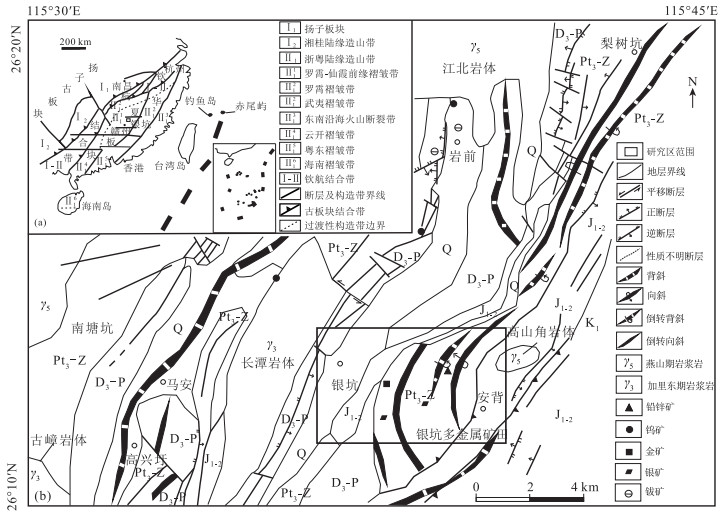
 下载:
下载:


